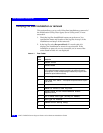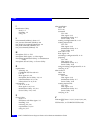
EMC CLARiiON Server Support Products for Windows Installation Guide
g-5
Glossary
non-RAID group
storage system
A storage system with SPs running a revision of FLARE software that
does not support RAID groups.
P
path See primary storage-system route.
primary
storage-system route
or primary route
In a storage system that has two SPs, each SP connects to each LUN
through a route indicated by the device name. The primary route
belongs to the SP that owns the LUN, and the secondary route
belongs to the other SP. The SP on which a LUN is bound is the
default owner of the unit. Knowing the routes is important because
you may need to transfer control to the secondary route in the event
of SP or Fibre Channel adapter failure.
R
RAID
(redundant array of
independent disks)
A technology with its own set of definitions. See RAID 0, RAID 1,
RAID 1/0, RAID 3, and RAID 5.
RAID 0 Three or more disk modules bound as striped disks (the storage
system reads and writes file information with more than one disk at a
time). RAID 0 offers enhanced performance via simultaneous I/O to
different modules, but does not intrinsically offer high availability.
For high availability, you can software mirror the striped disks.
RAID 1/0 Four, six, eight, ten, twelve, fourteen, or sixteen disk modules bound
as mirrored RAID 0 group. These disk modules make up two mirror
images of two, three, four, or five modules each. A RAID 1/0 group
combines the speed advantage of RAID 0 with the redundancy
advantage of mirroring.
RAID 1 Two bound disk modules that the storage-system hardware will
mirror.
RAID 3 Five modules that use disk striping (as with RAID 5). The hardware
maintains parity information that lets the group continue to run and
be rebuilt after a disk-module failure. With RAID 3, I/O occurs in
smaller blocks than with RAID 5, and parity information is stored on
one module, not distributed among all of them. RAID 3 works well
for single-task applications that use I/Os of one or more 2-Kbyte


















